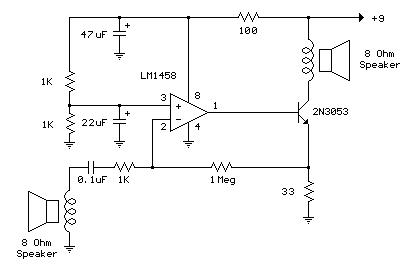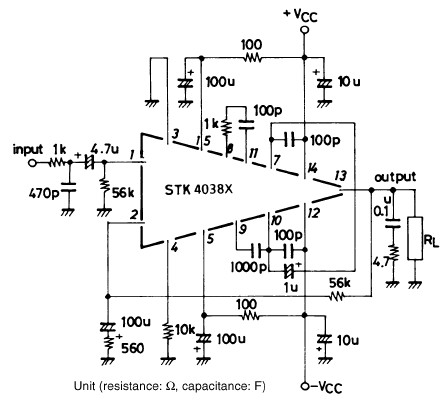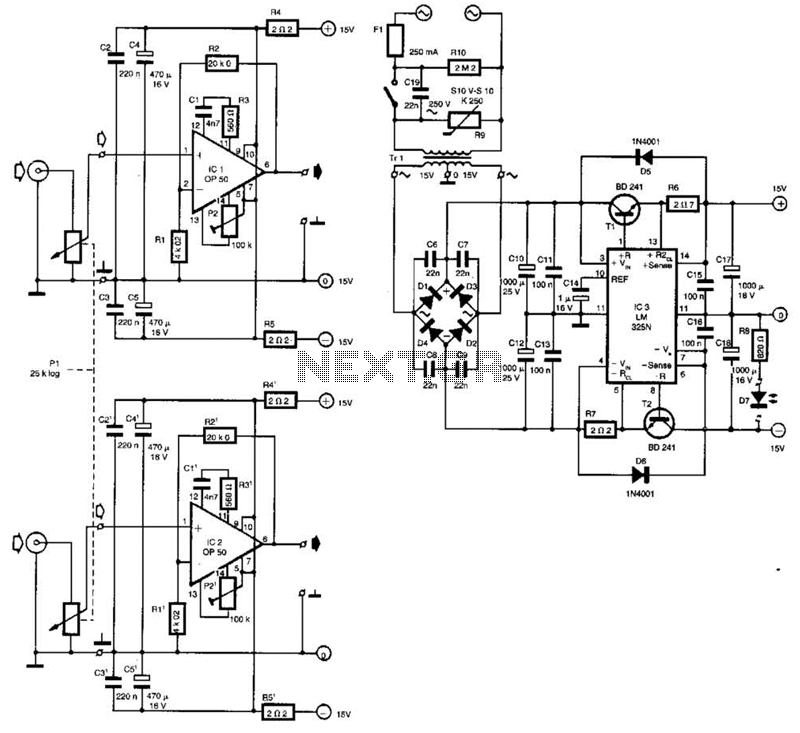
Low Power Op-Amp - Audio Amp (50 milliwatt) circuit

The example below illustrates the use of an operational amplifier (op-amp) as an audio amplifier in a basic intercom system. A small 8-ohm speaker is utilized as a microphone, which is connected to the op-amp input through a 0.1 µF capacitor. The speaker is sensitive to low frequencies, and the small capacitor helps to attenuate lower tones, resulting in an improved overall response.
In this audio amplifier configuration, the op-amp serves to amplify the audio signals captured by the 8-ohm speaker, which functions as a transducer converting sound waves into electrical signals. The 0.1 µF capacitor plays a crucial role in coupling the speaker to the op-amp input, allowing only the desired frequency range to pass through while blocking lower frequencies that could muddy the audio output. This selective filtering enhances the clarity and quality of the audio signal, making it more suitable for intercom applications.
The op-amp is typically configured in a non-inverting amplifier configuration, which provides a high input impedance, allowing the speaker to operate efficiently without loading it down. The gain of the amplifier can be set using feedback resistors, enabling customization of the output level to match the requirements of the intercom system. Power supply considerations must also be made, ensuring that the op-amp is powered adequately to handle the audio signal levels without distortion.
Overall, this simple intercom design effectively utilizes an op-amp to amplify audio signals while employing a small speaker as a microphone, combined with a capacitor for frequency response optimization. This approach demonstrates the versatility and functionality of op-amps in audio applications, particularly in low-cost and compact intercom systems.The example below illustrates using an op-amp as an audio amplifier for a simple intercom. A small 8 ohm speaker is used as a microphone which is coupled to the op-amp input through a 0.1uF capacitor. The speaker is sensitive to low frequencies and the small value capacitor serves to attenuate the lower tones and produce a better overall response..
🔗 External reference
In this audio amplifier configuration, the op-amp serves to amplify the audio signals captured by the 8-ohm speaker, which functions as a transducer converting sound waves into electrical signals. The 0.1 µF capacitor plays a crucial role in coupling the speaker to the op-amp input, allowing only the desired frequency range to pass through while blocking lower frequencies that could muddy the audio output. This selective filtering enhances the clarity and quality of the audio signal, making it more suitable for intercom applications.
The op-amp is typically configured in a non-inverting amplifier configuration, which provides a high input impedance, allowing the speaker to operate efficiently without loading it down. The gain of the amplifier can be set using feedback resistors, enabling customization of the output level to match the requirements of the intercom system. Power supply considerations must also be made, ensuring that the op-amp is powered adequately to handle the audio signal levels without distortion.
Overall, this simple intercom design effectively utilizes an op-amp to amplify audio signals while employing a small speaker as a microphone, combined with a capacitor for frequency response optimization. This approach demonstrates the versatility and functionality of op-amps in audio applications, particularly in low-cost and compact intercom systems.The example below illustrates using an op-amp as an audio amplifier for a simple intercom. A small 8 ohm speaker is used as a microphone which is coupled to the op-amp input through a 0.1uF capacitor. The speaker is sensitive to low frequencies and the small value capacitor serves to attenuate the lower tones and produce a better overall response..
🔗 External reference





